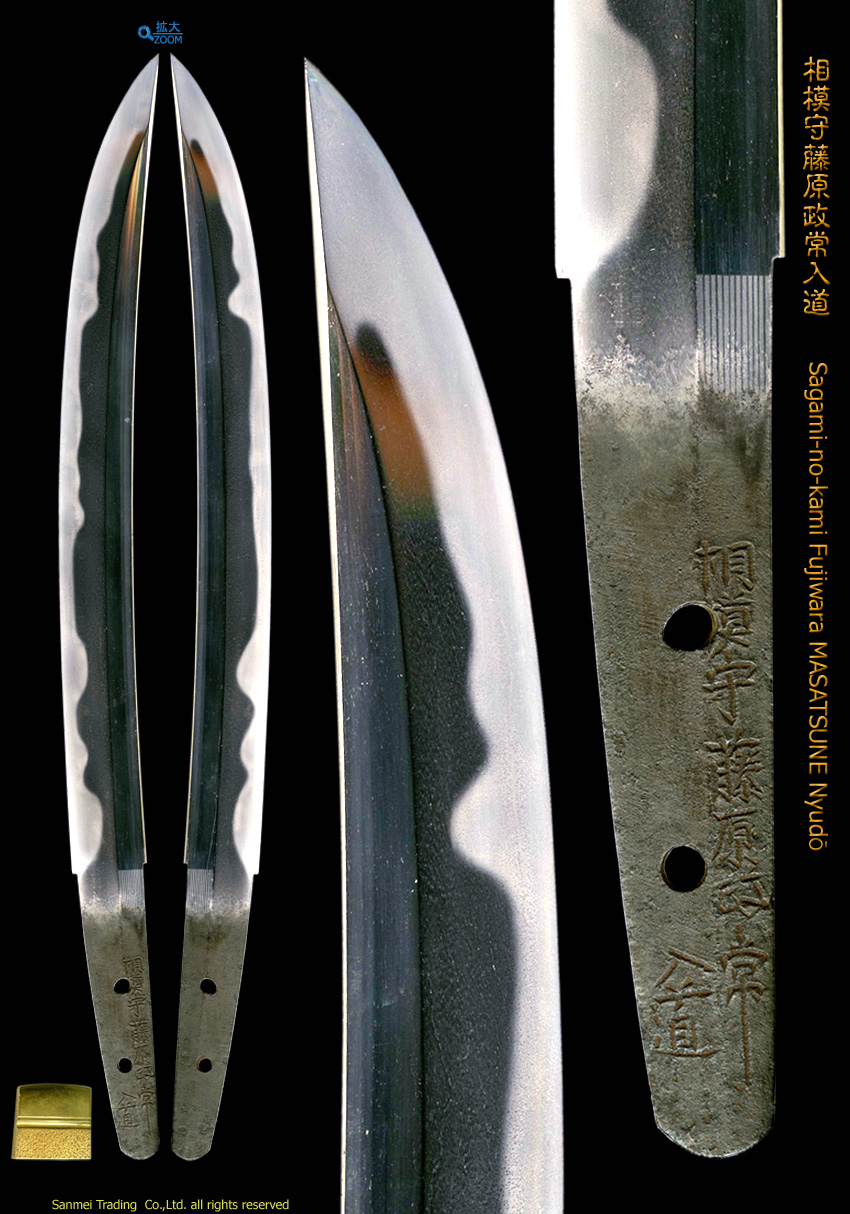Length of cutting edge 33.0cm Curvature 0.8cm Width of base 30.7mm Thickness of base 6.2mm
Forging pattern (kitae hada) : Kitae hada is conspicuous Itame hada mixing with large Mokume-hada partially. The surface is covered in intense Ji-nie hard metal granules over the surface with pronounced swirl Chikei darkish gleaming lines.
Tempering pattern (hamon) : Free and broad-minded manner of Hamon which is covered with rather on profuse and coarse side of Nie hard metal granules, starts with large Gunome of so called Koshiba on base then undulating Notare that consist from mixture of small Gunome zigzag and Tassel-shaoe Choji outline or complex various patterns to make up Box-shape. Upper the blade, stronger the Nie where works with Yubashiri of isolated temper area. The interior of temper where is filled with deep foggy granules of Nioi where works with frequent Sunagashi or Kinsen activities. A splashed temper of Tobiyaki appears on the Shinogi-ji in front.
Temper of tip (boshi) : Temper of tip is rather on stronger side of Nie that forms irregular pattern with an indication of Hakikake sweep in front and the other side is small circle turns back.
Tang (Nakago) : Nakago is unaltered in UBU original . Kurijiri double bevelled heel in full. Slanting Left Katte-sagari file marks. Two retaining holes of Mekugiana. The signature is chiselled on Shinogi-ji that starts with an official district Sagami-no-kami title 相模守 granted by the Imperial Court, the name of clan Fujiwara 藤原 and smith name MASATSUNE 政常 starting a new paragraph on Hiraji with a name of a monk Nyudō 入道.
The first smith MASATSUNE 初代政常, family name Nando 納戸, given name Sasuke 佐助, later changed to Tarōsuke 太郎助 . He is the second son of Nando Sukeuemon KANETSUNE 納戸助右衛門兼常 who is the 8th generation descendant of Nara-Tarō KANETSUNE 奈良太郎兼常, born in the 5th year of Tenbun (1534) , Nodo-town, Mino province (now Sen-nen town, Seki-city, Gifu-pref.)
In the 10th year of Eiroku (1567), when he was 33 years old, he had moved to Komaki-town, Kasuga-gun. He made 100 spears to the order of Tokugawa Ieyasu for the Battle of Komaki and Nagakute and was granted silver coins 銀子.
He was granted Sagami-no-kami title from Emperor in the 11th day, the 5th month, 20th year of Tensho (1592) then changed his smith name to MASA-TSUNE of which MASA was granted by Ikeda Terumasa, a feudal lord for that days in Komaki castle town.
When he was 55 years, in the 17th day, 11th month, the 5th year of Keicho (1592), he moved to Kiyosu town at the same time Matsudaira Tadayoshi (the 4th son of Tokugawa Ieyasu) became the Owari Kiyosu feudal lord. After the premature death of Matsudaira Tadayoshi in the 3rd month, the 12th year of Keicho (1607), at one point he had retired from the handling of practical affairs and his heir, the 2nd gen. Sagami-no-kami MASATSUNE succeeded.
In the 26th day, the 4th month, 12th year of Keicho (1607), Tokugawa Yoshinao (the 9th son of Tokugawa Ieyasu) replaced to be a feudal lord of Kiyosu castle town. Both 1st and 2nd gens. of MASATSUNE had exclusively worked for the vassals of the Owari Tokugawas with as much as a one hundred koku stipend.
However in the 14th year of Keicho (1609), his son 2nd gen. MASATSUNE died quite young, he made a comeback to the stage with the additionally signed monk name [Nyudō入道] at the end of his signature. He again moved to Tomita-town, Nagoya (now in Sakura-dōri Honmachi, Naka-ku, Nagoya) when Nagoya castle relocation in the 2nd month, the 15th year of Keicho(1610).
He has been highly praised for his major works mostly of spears, halberds and some Tantos or Ko-Wakizashi like this example but quite rare of existent Katana works. His extant works hold high dignity and enhances his reputation as the top expert of Owari artisan swordsmith as Saijo-saku Most Superior Made.
This blade is extravagantly swelling in full on upper fukura area and it's Shoshu workmanship is strongly influenced by Shizu works from Nanbokucho period. This trend came into vogue during Azuchi-Momoyama period among basara daimyo or unconventional warrior acting without restraint dandyism.
The signature inscription is thick and deep in typical upright style with a final stroke of TSUNE 常 is extraordinary long like this example. It is sufficiently convincing to add a monk name Nyudō 入道 that this work was made late in his life after he became a Buddhist priest on after Keicho 14th 1609. Passed away in the 28th day, 2nd month, the 5th year of Gen'na (1619), was 85 years old.
Single layer Gold foiled Habaki collar, preserved in a Shira-saya plain wood mounting.
Recent polish/Condition scale: excellent (using a scale of mint-excellent-very good-good-fair-poor)
reference data :
Iwata Atou Owari Tōkōfu Nagoya city Board of Education, 1985


